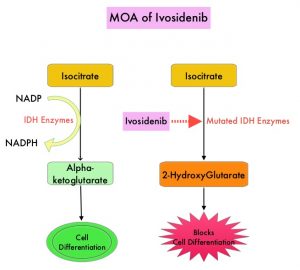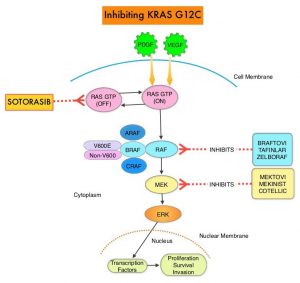SUMMARY: DNA damage is a common occurrence in daily life by UV light, ionizing radiation, replication errors, chemical agents, etc. This can result in single and double strand breaks in the DNA structure which must be repaired for cell survival. The vital pathways for DNA repair in a normal cell are BRCA1/BRCA2 and PARP. BRCA1 and BRCA2 genes recognize and repair double strand DNA breaks via Homologous Recombination Repair (HRR) pathway. Homologous Recombination is a type of genetic recombination, and is a DNA repair pathway utilized by cells to accurately repair DNA double-stranded breaks during the S and G2 phases of the cell cycle, and thereby maintain genomic integrity. Homologous Recombination Deficiency (HRD) is noted following mutation of genes involved in HR repair pathway.
BRCA1 and BRCA2 are tumor suppressor genes located on chromosome 17 and chromosome 13 respectively and functional BRCA proteins repair damaged DNA, and play an important role in maintaining cellular genetic integrity. They regulate cell growth and prevent abnormal cell division and development of malignancy. Mutations in these genes predispose an individual to develop malignant tumors.
BRCA mutations can either be inherited (Germline) and present in all individual cells or can be acquired and occur exclusively in the tumor cells (Somatic). Somatic mutations account for a significant portion of overall BRCA1 and BRCA2 aberrations. Loss of BRCA function due to frequent somatic aberrations likely deregulates HR pathway, and other pathways then come in to play, which are less precise and error prone, resulting in the accumulation of additional mutations and chromosomal instability in the cell, with subsequent malignant transformation. Homologous Recombination Deficiency therefore indicates an important loss of DNA repair function.
Pathogenic Variants (PVs) in BRCA1 and BRCA2 (BRCA1/2) are well known to be associated with increased lifetime risk for breast and ovarian cancer in women, and reliable risk estimates are also available and can be as high as 85% and 40% respectively. However, the association of BRCA1 and BRCA2 Pathogenic Variants with cancers other than female breast and ovarian cancers remain uncertain, and these associations have been based on studies with relatively small sample sizes, resulting in imprecise cancer risk estimates. It is therefore important that precise risk estimates are available, in order to optimize clinical management strategies and guidelines for cancer risk management in female and male BRCA1/2 carriers. The NCCN and other guidelines recommend breast and ovarian cancer screening for BRCA1/2 carriers, prostate cancer screening for BRCA2 carriers. Screening is also recommended for pancreatic cancer in BRCA1/2 carriers, but only in the presence of a positive family history of the disease.
The researchers conducted this study to evaluate the association of BRCA1 and BRCA2 pathogenic variants, with additional cancer types and their clinical characteristics associated with pathogenic variant carrier status. For this study, a large-scale registry based sequencing study was performed across 14 common cancer types in 63, 828 patients and 37, 086 controls, whose data were drawn from a Japanese nationwide multi-institutional hospital-based biobank, between 2003 and 2018. In the study group, the median age was 64 years and 42% were female, whereas the median age was 62 years and 47% were female in the control group. Germline pathogenic variants were identified in the BRCA1 and BRCA2 genes by a multiplex Polymerase Chain Reaction-based target sequence method. Associations of (likely) pathogenic variants with each cancer type were assessed by comparing pathogenic variant carrier frequency between patients in each cancer type and controls. Compared with the researchers previous publications for breast, colorectal, pancreatic, and prostate cancers, this study included 14,448 additional controls and 8247 additional cancer cases. These data thus provided a broad view of cancer risks associated with pathogenic variants in BRCA1 and BRCA2 genes.
Pathogenic variants in BRCA1 were significantly associated with increased risk for three other types of cancer types, Biliary tract (Odds Ratio–OR=17.4), Gastric (OR=5.2), and Pancreatic cancer (OR=12.6), in addition to female Breast (OR=16.1) and Ovarian cancer (OR=75.6). Pathogenic variants in BRCA2 increased risk for seven cancer types which included female Breast (OR=10.9), male Breast (OR=67.9), Gastric (OR=4.7), Ovarian (OR=11.3), Pancreatic (OR=10.7), Prostate (OR=4.0), and Esophageal cancer (OR=5.6). Further, Biliary tract, female Breast, Ovarian, and Prostate cancers showed enrichment of carrier patients according to the increased number of reported cancer types in relatives.
The results of this large study suggested that pathogenic variants in BRCA1 and/or BRCA2 are associated with increased risk of biliary tract, gastric, and esophageal cancers, higher than for European populations, granted that these cancers are known to have a higher incidence rate in East Asian countries. Conversely in this study, the cumulative risk of prostate cancer for BRCA2 carriers was lower than that estimated in the UK and Ireland, suggesting that the cumulative risk for each cancer type may be associated with the different incidence rate in each country.
The authors concluded that this study suggested that pathogenic variants in BRCA1 and BRCA2 were associated with the risk of 7 cancer types and is likely broader than that determined from previous analysis of largely European ancestry cohorts. It would therefore be useful to expand indications for genetic testing of individuals with family history of these cancer types.
Expansion of Cancer Risk Profile for BRCA1 and BRCA2 Pathogenic Variants. Momozawa Y, Sasai R, Usui Y, et al. JAMA Oncol. 2022 Apr 14: e220476. doi: 10.1001/jamaoncol.2022.0476 [Epub ahead of print]


